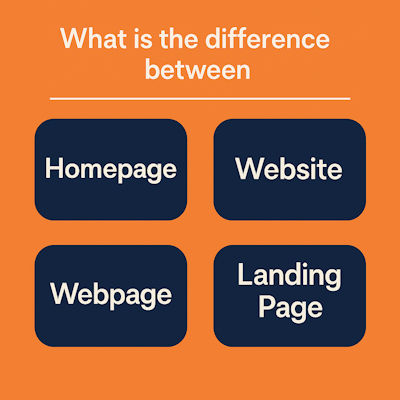In the world of digital communication, the terms homepage, website, webpage, and landing page are often used interchangeably—but they shouldn’t be. While closely related, each of these elements plays a specific role in how information is structured and delivered online. Understanding the difference is crucial for marketers, developers, designers, and anyone working with online content.

In this post, we’ll break down each term and explain the key distinctions in simple, practical language.
1. Website: The Entire Online Presence
A website is the complete collection of related digital content that lives under a single domain name (like www.yourcompany.com). It typically includes multiple pages, such as:
- A homepage
- About Us
- Services or Products
- Contact
- Blog or News section
- Legal pages (Privacy Policy, Terms of Service, etc.)
Think of a website as a house. It contains multiple rooms (pages), each with its own purpose, but all under one roof.
Key Characteristics of a Website:
- Hosted under a domain name
- Accessible via the internet or intranet
- Includes internal navigation between pages
- Serves multiple goals: branding, sales, support, etc.
Example: When you visit www.apple.com, you’re on Apple’s website. Within it, you’ll find various webpages like product pages, support, and more.
2. Webpage: A Single Page on a Website
A webpage is a single document on the internet, usually written in HTML, and accessible through a unique URL. It’s just one part of the overall website.
Using the house analogy again, a webpage is like a single room within that house.
Examples of Webpages:
- www.yourcompany.com/about-us – the “About Us” page
- www.yourcompany.com/contact – contact form
- www.blogsite.com/how-to-grow-your-business – blog article
Key Points:
- Every page you visit is a webpage.
- A website is composed of many webpages.
- Webpages can link to each other internally or externally.
3. Homepage: The Front Door of a Website
The homepage is the main entry point of a website, typically accessible at the root URL (e.g. www.yourcompany.com). It gives the first impression and provides key navigation.
Homepage Functions:
- Introduce the brand or purpose
- Offer navigation to key sections
- Highlight featured content
- Establish visual tone and trust
Example: www.nike.com loads Nike’s homepage, which then links to various product and campaign pages.
4. Landing Page: Designed for a Specific Goal
A landing page is a standalone page created with one clear objective—usually part of a marketing campaign. It often follows a paid ad, email, or social link.
Typical Goals of a Landing Page:
- Generate leads (e.g. email addresses)
- Promote a product or service
- Offer a free resource (eBook, guide, etc.)
- Encourage a conversion (purchase, signup, etc.)
Key Characteristics:
- Minimal navigation
- Strong call-to-action (CTA)
- Often part of a sales or lead funnel
Example: A Facebook ad for a course might lead to www.learnonline.com/free-trial — a focused landing page to drive signups.
Visual Comparison
| Term | Scope | Purpose | Navigation | Example URL |
|---|---|---|---|---|
| Website | Entire entity | Multiple goals | Full navigation | www.company.com |
| Webpage | Single page | Specific content | Yes | www.company.com/services |
| Homepage | Main entry | Overview, navigation | Yes | www.company.com |
| Landing Page | Single page | One action | Minimal | www.company.com/ebook-download |
Common Misconceptions
“Is the homepage the same as the website?”
No. The homepage is just one part of the website—the front page—but the website includes all the other pages and content as well.
“Can a landing page be part of a website?”
Yes. Landing pages often live on the same domain or subdomain but are designed for specific campaigns or conversions.
“Is every webpage a landing page?”
No. While every landing page is a webpage, not every webpage is a landing page. Landing pages have a unique purpose and structure.
Conclusion
To recap:
- Website: The full collection of online content under a domain
- Webpage: Any individual page within that website
- Homepage: The main entry page of the site
- Landing Page: A focused, conversion-driven page for marketing purposes
Understanding these differences can improve communication, planning, and execution in digital projects. Use the right terminology, and your team (and your website visitors) will thank you.
Need help with your homepage, landing pages, or complete website?
We’d be happy to support your project. Get in touch today.
Have a great day!
